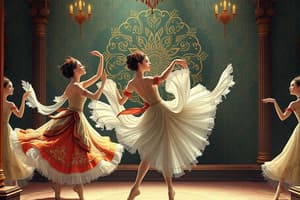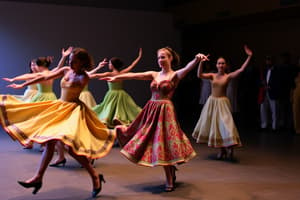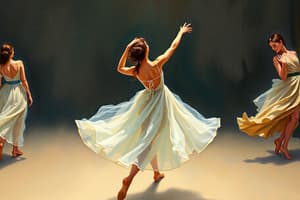Podcast
Questions and Answers
Which of the following dance forms does NOT belong to the category of traditional dances?
Which of the following dance forms does NOT belong to the category of traditional dances?
- Ballroom Dance
- Folk Dance
- Hip-Hop Dance (correct)
- Festival Dances
What is the first position of the arms typically used for in dance?
What is the first position of the arms typically used for in dance?
- Creating curves in movements
- Providing balance and posture (correct)
- Enhancing footwork speed
- Facilitating partner interaction
Which dance form is characterized by its energetic, rhythm-based movement style and often performed in competitions?
Which dance form is characterized by its energetic, rhythm-based movement style and often performed in competitions?
- Contemporary Dance
- Folk Dance
- Ballroom Dance
- Cheerdance (correct)
Which position of the arms is typically considered the fourth position in dance?
Which position of the arms is typically considered the fourth position in dance?
Which dance style includes elements of acrobatics and improvisation, often associated with urban culture?
Which dance style includes elements of acrobatics and improvisation, often associated with urban culture?
What fundamentally characterizes dance?
What fundamentally characterizes dance?
Which of the following is NOT a reason why people dance?
Which of the following is NOT a reason why people dance?
Which element of dance describes the dancer's movements and their physical presence?
Which element of dance describes the dancer's movements and their physical presence?
What does the 'Action' element of dance encompass?
What does the 'Action' element of dance encompass?
When considering the element of space, which aspect is NOT typically included?
When considering the element of space, which aspect is NOT typically included?
Which of the following best describes the 'Energy' element of dance?
Which of the following best describes the 'Energy' element of dance?
How can movements in dance vary concerning space?
How can movements in dance vary concerning space?
Which of the following best encapsulates why dance is considered an expression of feelings?
Which of the following best encapsulates why dance is considered an expression of feelings?
Flashcards are hidden until you start studying
Study Notes
Learning Objectives
- Define dance and its significance as an art form.
- Explore the various reasons people engage in dance.
- Identify key elements and forms of dance.
What is Dance?
- Dance is an expression involving a series of movements synchronized with music.
- Key features include:
- Movement of the body including hands, arms, and head.
- Ability to move from one space to another.
Why Do People Dance?
- Functions of dance include:
- Role in worship and spiritual expression.
- Use in courtship practices.
- Provides entertainment and enjoyment.
- Aesthetic expression that inspires beauty in others.
- Can symbolize victory or facilitate emotional healing.
Elements of Dance
- Body: The dancer's mobile figure or shape can emphasize specific body parts or utilize the whole body.
- Action: Encompasses any human movement during dance, including steps, facial expressions, lifts, and catches.
- Space: Dancers may move within a specific area or travel, changing direction, level, size, and pathways of movements.
- Time: Relates to the timing and rhythm of movements within the dance.
- Energy: Expresses the force of body motions, with variations like hard or gentle movements, including bounce, shake, or explosive actions.
Dance Forms
- Various forms of dance include:
- Modern and Contemporary Dance
- Traditional (Folk & Ethnic) Dance
- Ballroom Dance
- Cheer dance
- Hip-Hop/Street Dance & Festival Dances
Fundamental Steps
- Basic positions of arms and feet in dance include:
- First Position
- Second Position
- Third Position
- Fourth Position
- Fifth Position
Activity Direction
- An exercise prompts selecting a familiar dance and describing it.
- Participants are encouraged to choose a dance they wish to learn and articulate their interest.
Studying That Suits You
Use AI to generate personalized quizzes and flashcards to suit your learning preferences.




